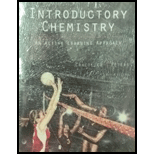
Concept explainers
Interpretation:
The reason as to why the redox reactions are described as electron transfer reactions is to be stated.
Concept introduction:
The reactions in which one compound undergoes oxidation while the other undergoes reduction are termed as redox reactions. The molecule or compound which loses one or more electrons is said to be oxidized. The molecule or compound which gains one or more electrons is said to be reduced.
Answer to Problem 1E
The redox reactions are described as electron transfer reactions as the electrons released from the atoms of the molecule in oxidation half-reaction are transferred to the ions of the other molecule in reduction half-reaction.
Explanation of Solution
The reaction in which one molecule gets oxidized while the other gets reduced simultaneously is known as a
The reaction given below is an example of a redox reaction.
The redox reaction that is shown above can be split into two half reactions.
The oxidation half-reaction is shown below.
The reduction half-reaction is shown below.
The oxidation half-reaction shows that the electrons are released and the reduction half-reaction shows that the electrons are utilized. This means that the electrons released from zinc atoms in the oxidation half-reaction are transferred to the copper ions in the reduction half-reaction. Therefore, redox reactions are described as electron transfer reactions.
The electrons are released during the oxidation half-reaction and transferred to the reduction half-reaction. Therefore, the redox reactions are described as electron transfer reactions.
Want to see more full solutions like this?
Chapter 19 Solutions
Bundle: Introductory Chemistry: An Active Learning Approach, 6th + LMS Integrated for OWLv2, 4 terms (24 months) Printed Access Card
 Introductory Chemistry: An Active Learning Approa...ChemistryISBN:9781305079250Author:Mark S. Cracolice, Ed PetersPublisher:Cengage Learning
Introductory Chemistry: An Active Learning Approa...ChemistryISBN:9781305079250Author:Mark S. Cracolice, Ed PetersPublisher:Cengage Learning Chemistry: Principles and PracticeChemistryISBN:9780534420123Author:Daniel L. Reger, Scott R. Goode, David W. Ball, Edward MercerPublisher:Cengage LearningChemistry: Matter and ChangeChemistryISBN:9780078746376Author:Dinah Zike, Laurel Dingrando, Nicholas Hainen, Cheryl WistromPublisher:Glencoe/McGraw-Hill School Pub Co
Chemistry: Principles and PracticeChemistryISBN:9780534420123Author:Daniel L. Reger, Scott R. Goode, David W. Ball, Edward MercerPublisher:Cengage LearningChemistry: Matter and ChangeChemistryISBN:9780078746376Author:Dinah Zike, Laurel Dingrando, Nicholas Hainen, Cheryl WistromPublisher:Glencoe/McGraw-Hill School Pub Co World of Chemistry, 3rd editionChemistryISBN:9781133109655Author:Steven S. Zumdahl, Susan L. Zumdahl, Donald J. DeCostePublisher:Brooks / Cole / Cengage Learning
World of Chemistry, 3rd editionChemistryISBN:9781133109655Author:Steven S. Zumdahl, Susan L. Zumdahl, Donald J. DeCostePublisher:Brooks / Cole / Cengage Learning Living By Chemistry: First Edition TextbookChemistryISBN:9781559539418Author:Angelica StacyPublisher:MAC HIGHER
Living By Chemistry: First Edition TextbookChemistryISBN:9781559539418Author:Angelica StacyPublisher:MAC HIGHER Chemistry for Today: General, Organic, and Bioche...ChemistryISBN:9781305960060Author:Spencer L. Seager, Michael R. Slabaugh, Maren S. HansenPublisher:Cengage Learning
Chemistry for Today: General, Organic, and Bioche...ChemistryISBN:9781305960060Author:Spencer L. Seager, Michael R. Slabaugh, Maren S. HansenPublisher:Cengage Learning





